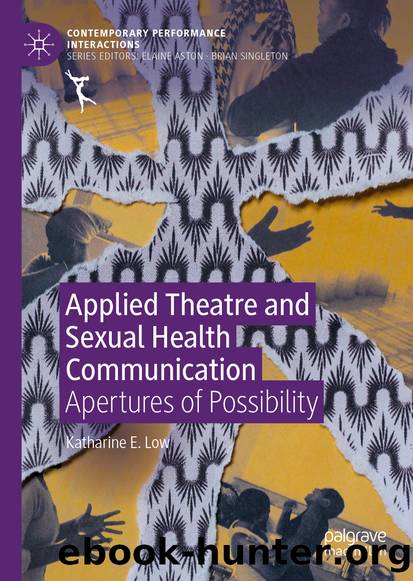Applied Theatre and Sexual Health Communication by Katharine E. Low

Author:Katharine E. Low
Language: eng
Format: epub
ISBN: 9781349959754
Publisher: Palgrave Macmillan UK
These disruptions also regularly appeared in the participantsâ improvised scenes and images, an occurrence which is notable when the focus of the project was sexual health. Yet this was a great catalyst for me in terms of understanding how the applied theatre process might workâthe project could not be silo-ed around sexual health; rather, the porous boundaries of the workshop space helped complicate understandings of sexual heath. The disharmonious rhythms of their outside lives also reverberated within the workshop site. For example, one morning, while Sikelelwa and Zimkhitha walked through Nyanga to attend an OPOS workshop, they were accosted by a man who demanded their shoes from them, threatening violence if they did not comply. Running away from the man and keeping their shoes, Sikelelwa and Zimkhitha arrived in a state of agitation, and their arrhythmic experience echoed within our workshop space. That day, throughout the workshop, they were on edge, a rhythm which ricocheted into the drama space and affected other participantsâ rhythms.
Based on these examples, I read Nyangaâs rhythms as being in a state of what Lefebvre describes as âdérèglementâ (malfunction or disorder) which âthrows out of order and disrupts; it is symptomatic of a disruption that is generally profound, lesional and no longer functionalâ (2004: 44, emphasis in original). Indeed, it was impossible not to recognise the rhythms and tremors which came into the space in the form of the participantsâ fears, experiences, and desires to talk about the crime and violence facing them. While I did try to establish a safe applied theatre space, it was quickly apparent that it was not possible to keep the space safe and maintain boundaries. These events highlighted to me the complicated relationship between inside and outside spaces within theatre practice. For this project, coupled with the difficulty of discussing safe sexual health in an unsafe environment, there was a need for a further analysis of space and its perceived safety in applied theatre practice. It became apparent that a more open understanding of space was necessary; one that was attentive to the fluidity of the site and the differing narratives found within it. This highlighted the porous nature of boundaries, but also complicated ideas of the safety of spaces, which was revolutionary to my thinking at the time. It occurred to me that something else can happen in the workshop space if the need for a safe space is released. For us, letting go was a step towards having more tangible conversations about sex, and this became possible as we built a shared vocabulary.
Download
This site does not store any files on its server. We only index and link to content provided by other sites. Please contact the content providers to delete copyright contents if any and email us, we'll remove relevant links or contents immediately.
Call Me by Your Name by André Aciman(20373)
Ready Player One by Cline Ernest(14525)
How to Be a Bawse: A Guide to Conquering Life by Lilly Singh(7393)
Wiseguy by Nicholas Pileggi(5671)
The Kite Runner by Khaled Hosseini(5084)
On Writing A Memoir of the Craft by Stephen King(4863)
Audition by Ryu Murakami(4850)
The Crown by Robert Lacey(4723)
Call me by your name by Andre Aciman(4619)
Gerald's Game by Stephen King(4583)
Harry Potter and the Cursed Child: The Journey by Harry Potter Theatrical Productions(4440)
Dialogue by Robert McKee(4321)
The Perils of Being Moderately Famous by Soha Ali Khan(4169)
Dynamic Alignment Through Imagery by Eric Franklin(4118)
Apollo 8 by Jeffrey Kluger(3637)
Seriously... I'm Kidding by Ellen DeGeneres(3577)
The Inner Game of Tennis by W. Timothy Gallwey(3575)
How to be Champion: My Autobiography by Sarah Millican(3555)
Darker by E L James(3479)
